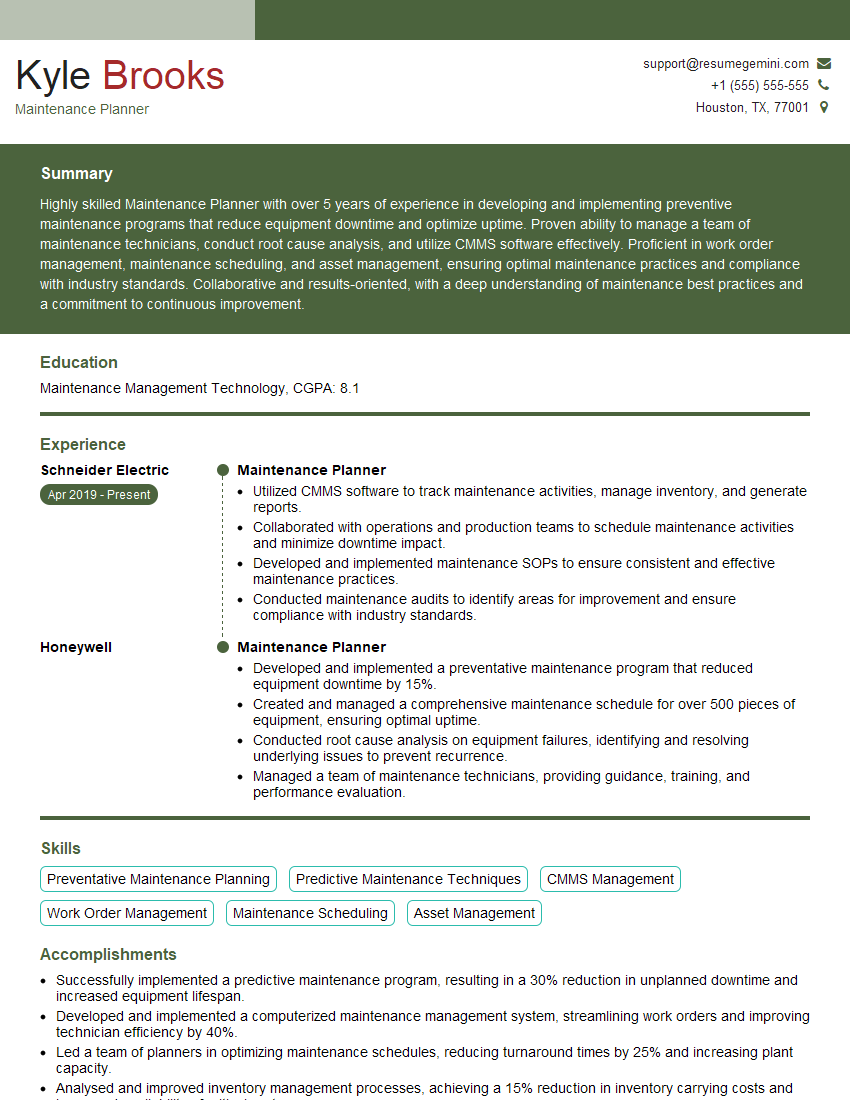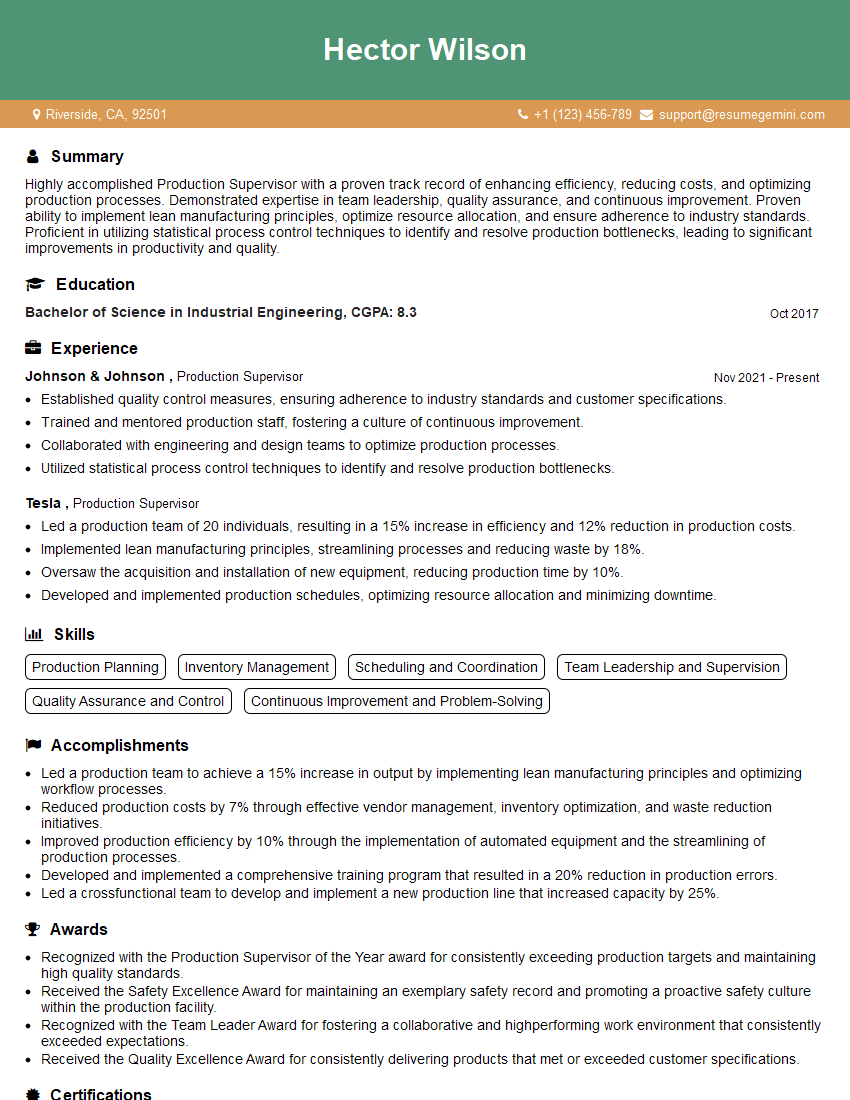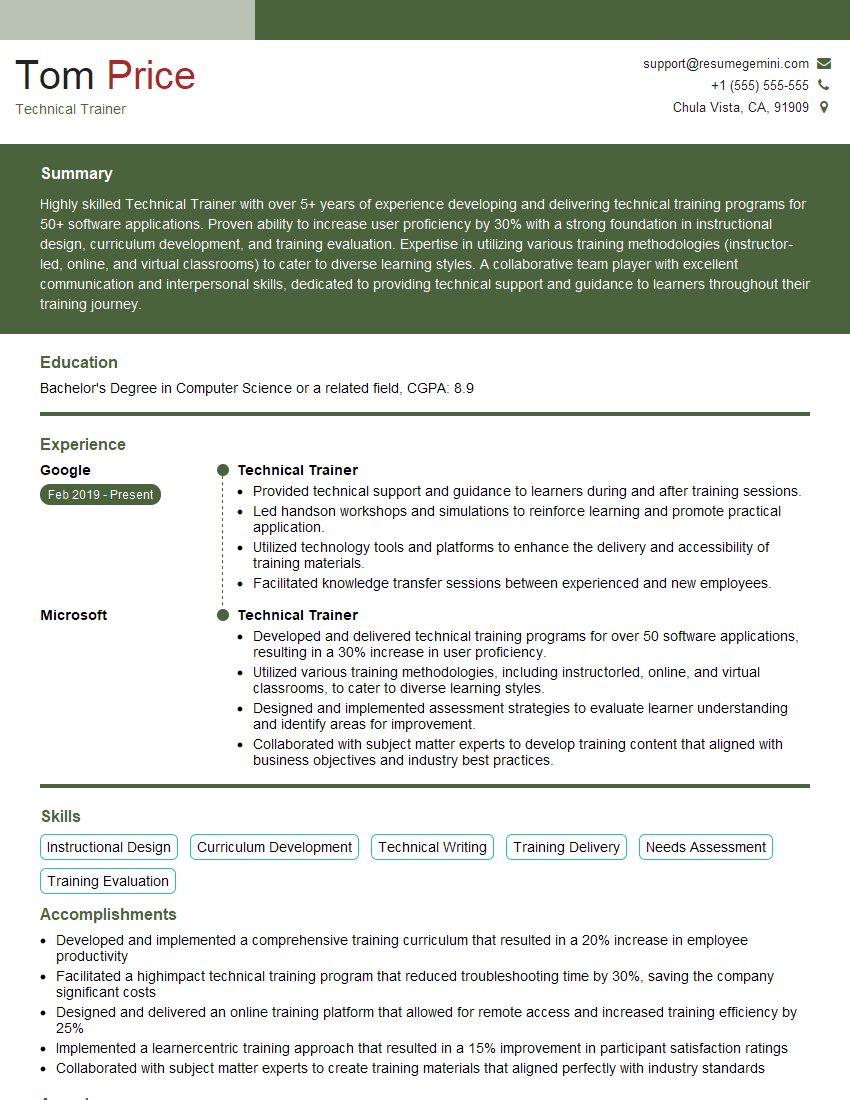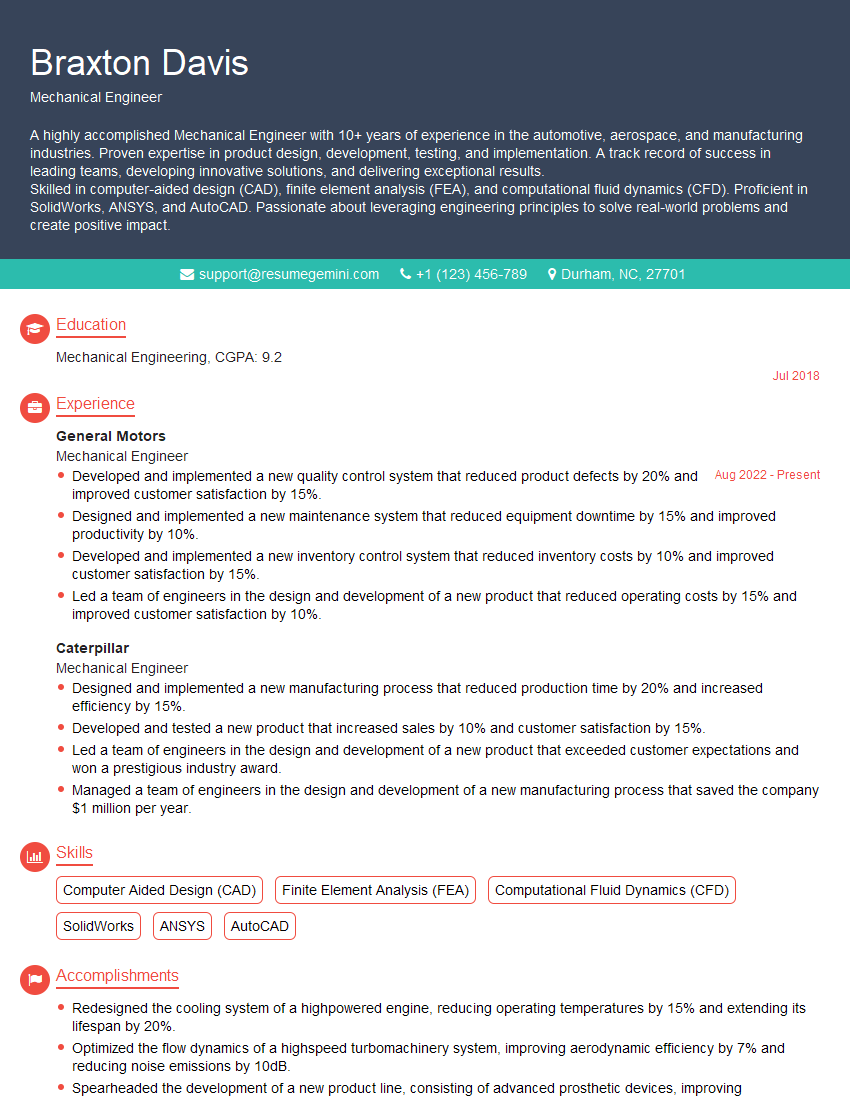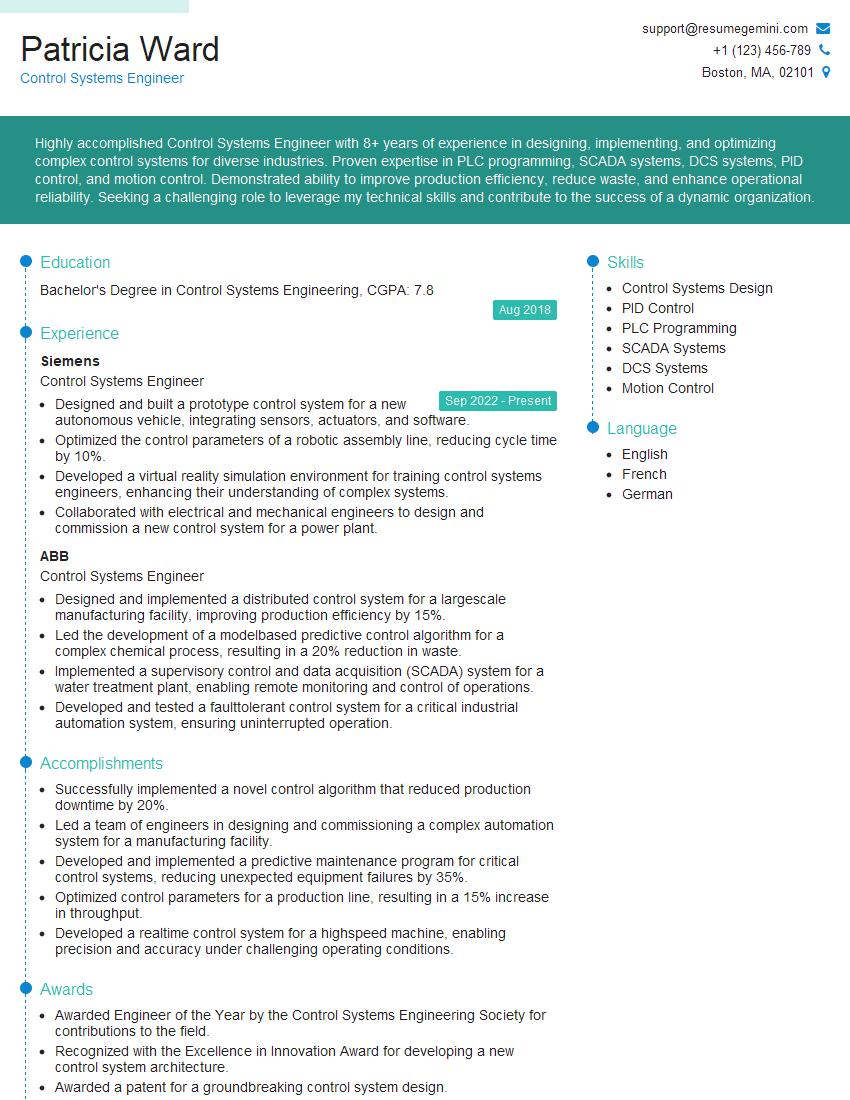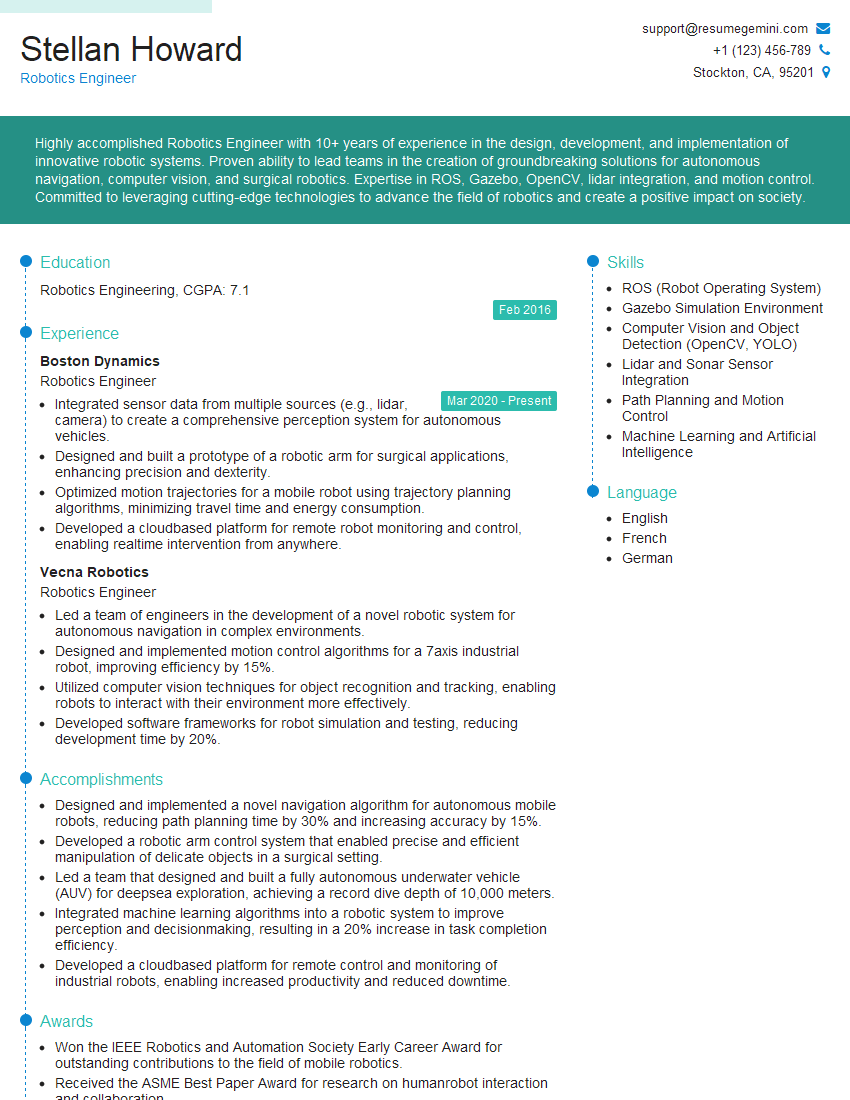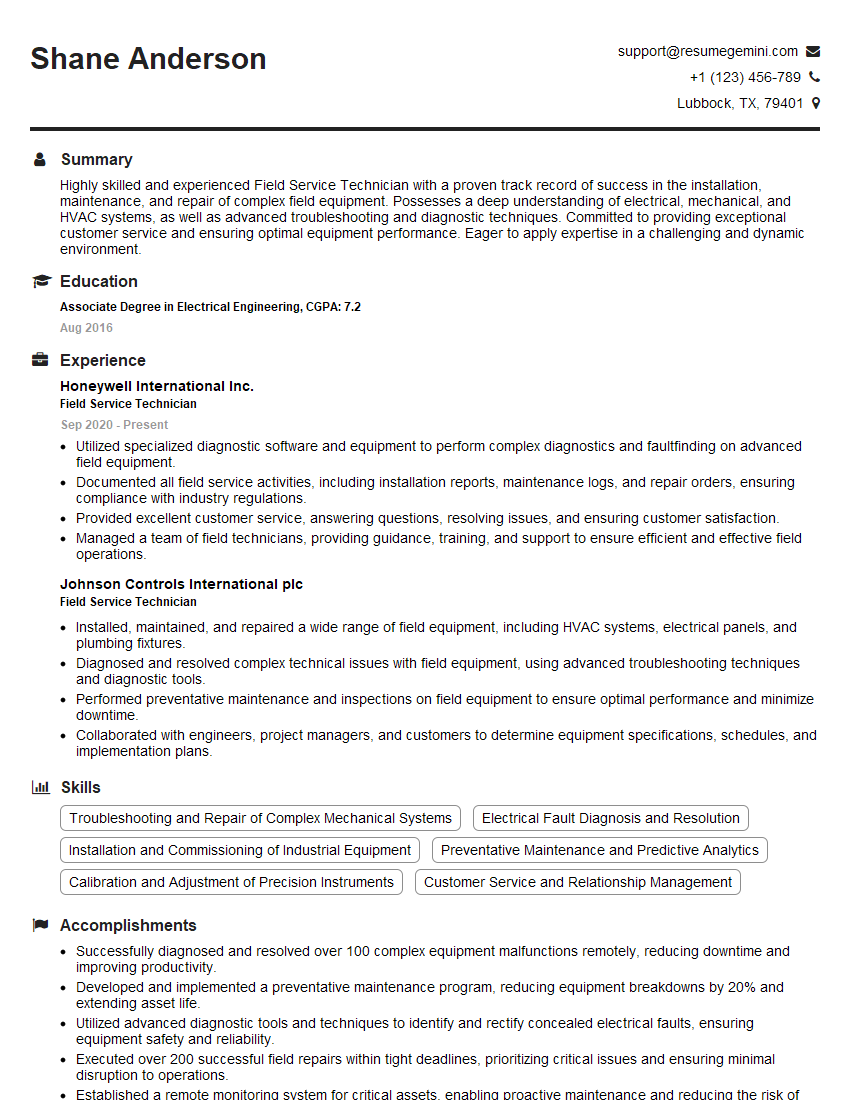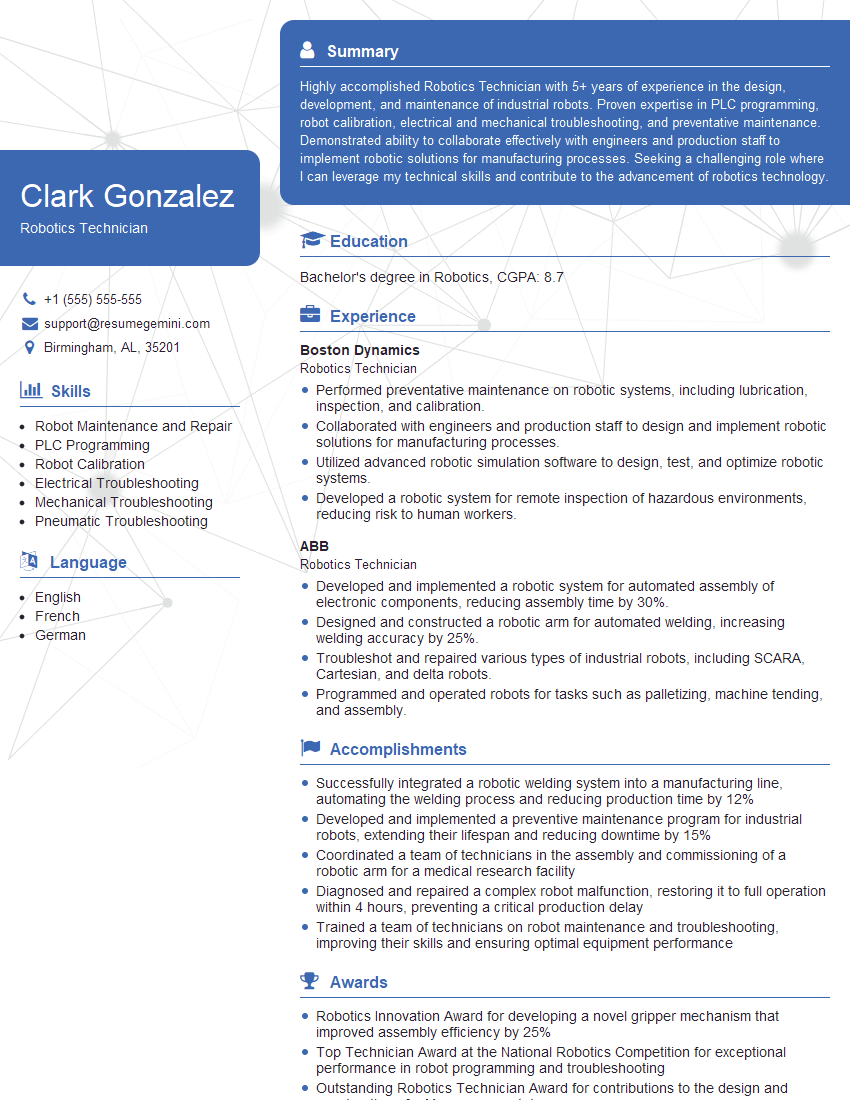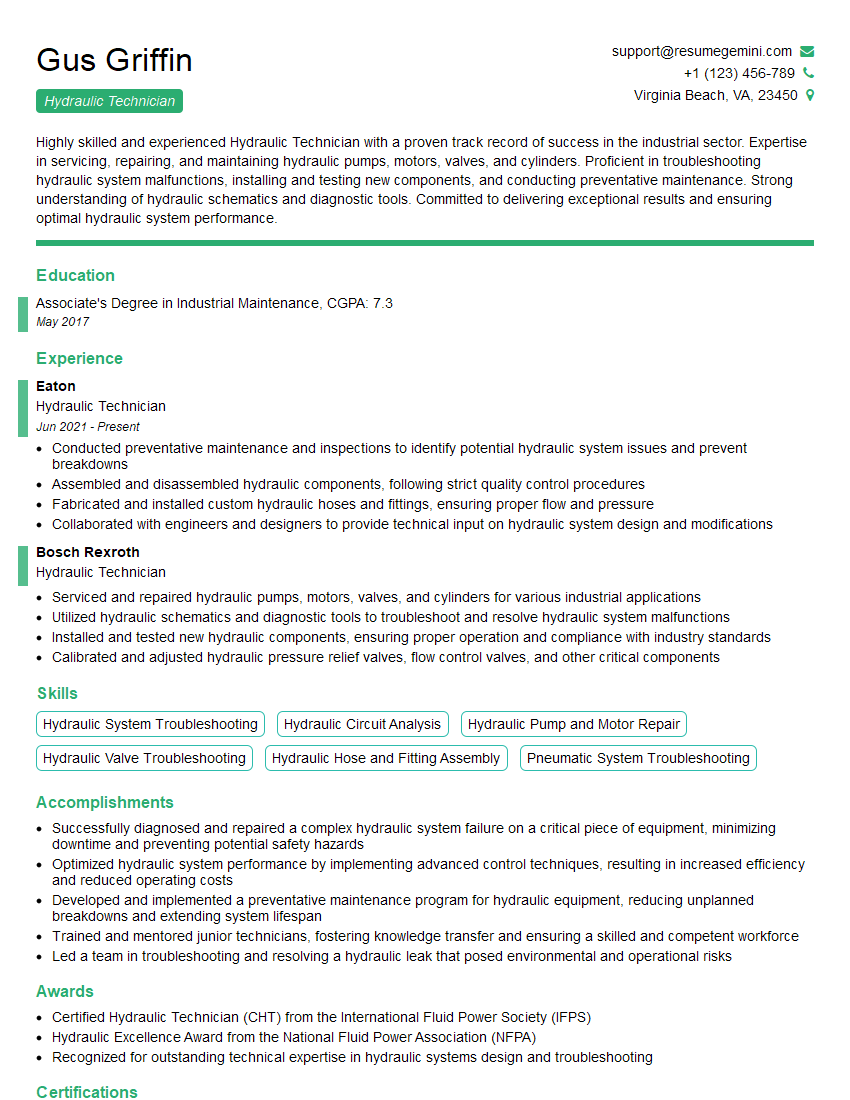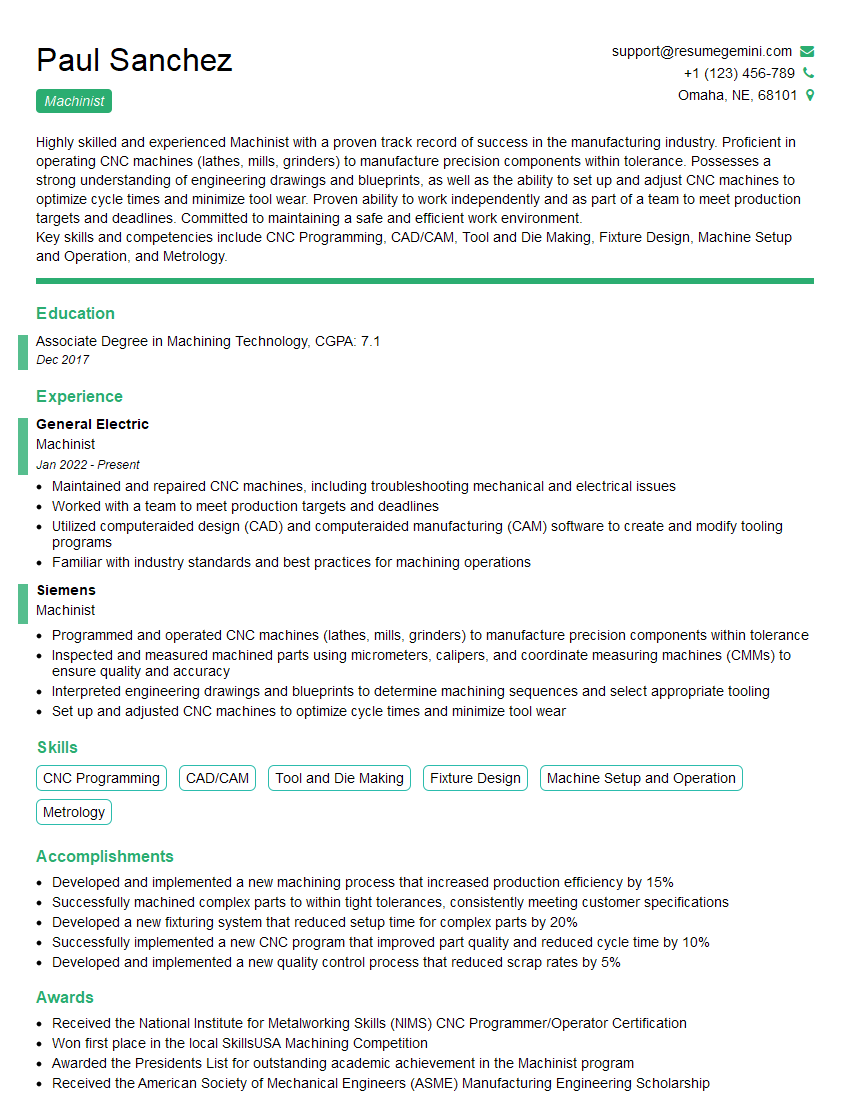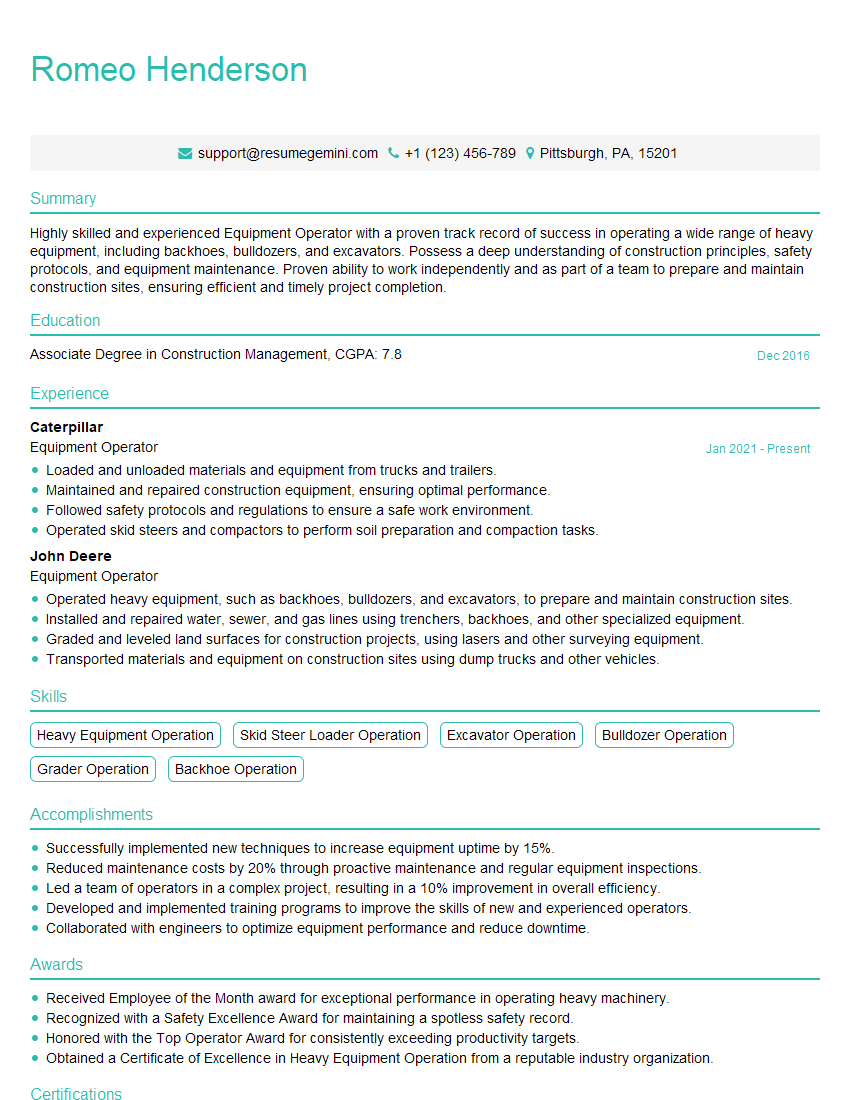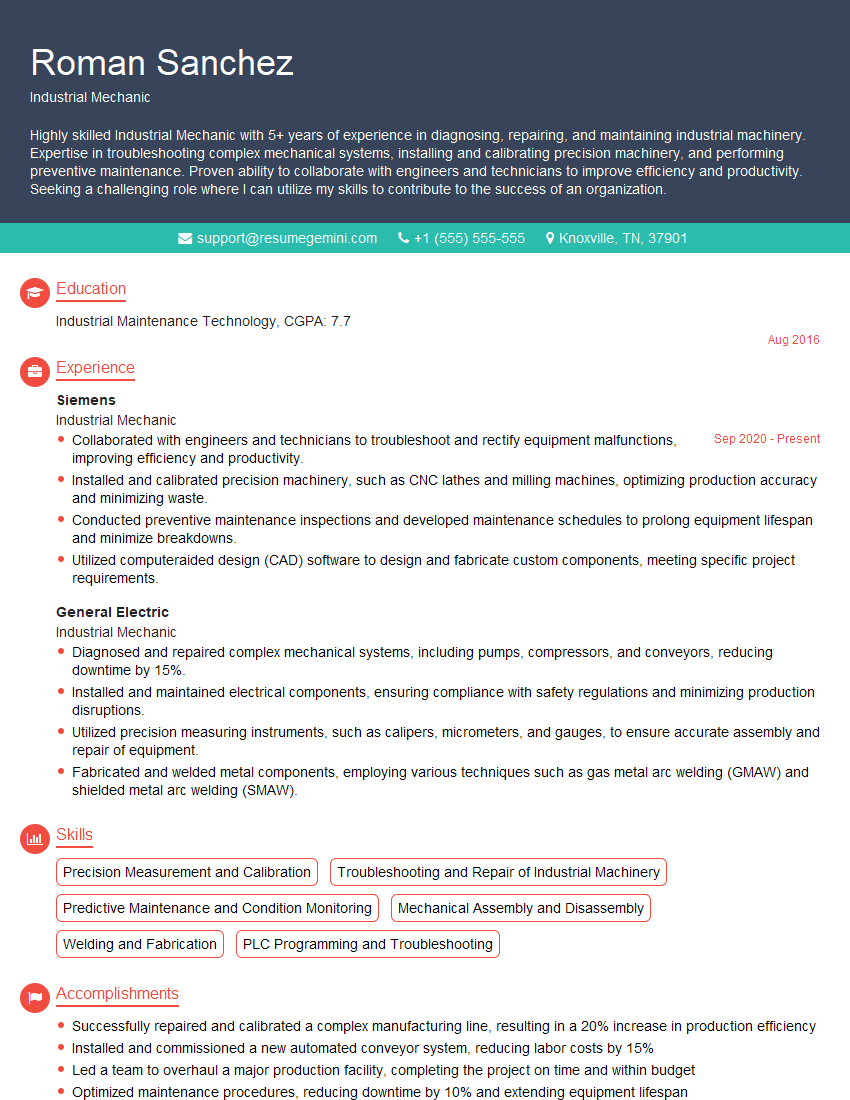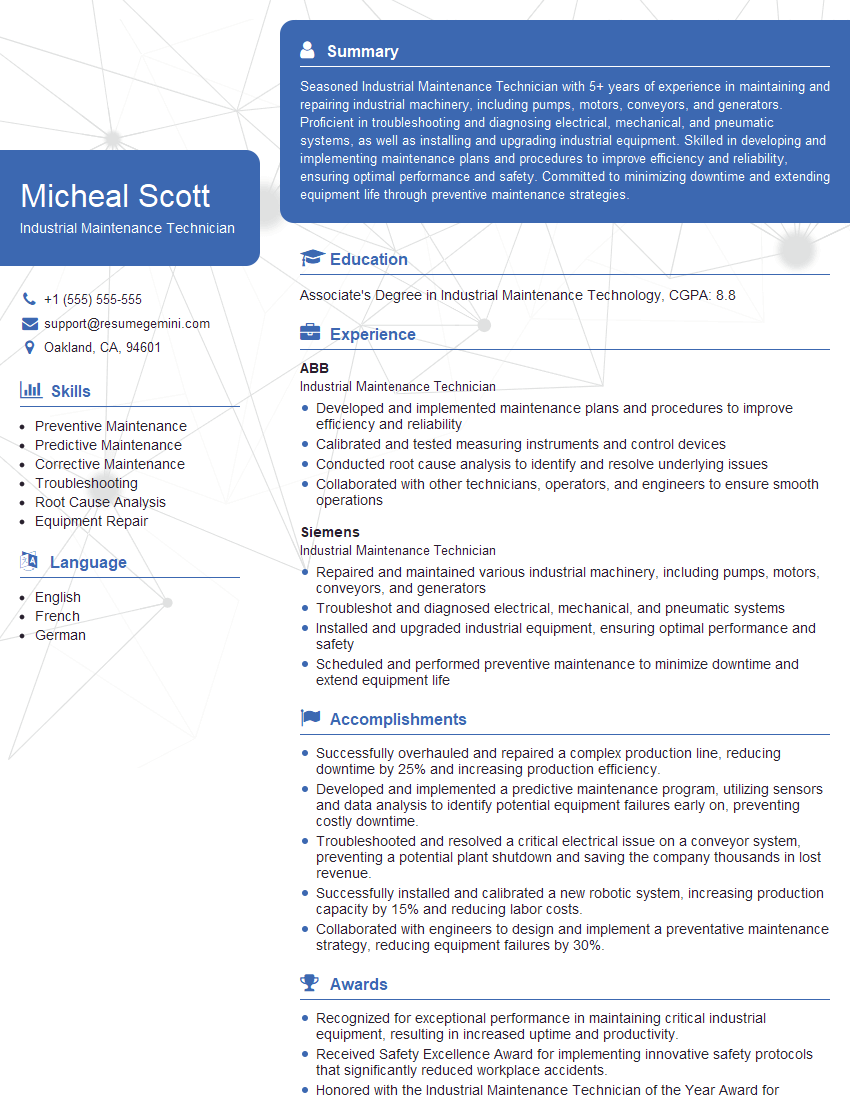Unlock your full potential by mastering the most common Working with Industrial Machinery interview questions. This blog offers a deep dive into the critical topics, ensuring you’re not only prepared to answer but to excel. With these insights, you’ll approach your interview with clarity and confidence.
Questions Asked in Working with Industrial Machinery Interview
Q 1. Describe your experience troubleshooting industrial machinery malfunctions.
Troubleshooting industrial machinery malfunctions requires a systematic approach. It starts with a thorough understanding of the machine’s operation and a careful assessment of the problem. I begin by gathering information: observing the malfunction, checking error codes (if available), reviewing maintenance logs, and interviewing operators to understand the context of the failure. Then, I move towards a diagnostic process which often involves:
- Visual Inspection: Looking for obvious signs of damage, leaks, loose connections, or wear and tear.
- Testing: Using multimeters, pressure gauges, and other diagnostic tools to measure voltages, currents, pressures, and other parameters.
- Component Isolation: Systematically isolating components to pinpoint the source of the problem. This might involve temporarily disconnecting parts or substituting known good components.
- Root Cause Analysis: Once the faulty component is identified, I investigate the underlying cause of the failure. This could be due to wear and tear, improper operation, design flaws, or external factors.
For example, I once worked on a conveyor belt system that stopped unexpectedly. Initial inspection revealed no obvious issues. However, after careful testing, I discovered a failing motor capacitor causing intermittent power loss. Replacing the capacitor resolved the issue. Another time, a sudden drop in hydraulic pressure in a stamping press pointed towards a leak in a hydraulic line. Using a pressure gauge, I pinpointed the leak and promptly replaced the section of the line.
Q 2. Explain the process of preventative maintenance on a specific type of industrial machinery.
Preventative maintenance (PM) is crucial for extending the lifespan and ensuring the reliable operation of industrial machinery. Let’s take a CNC milling machine as an example. A comprehensive PM schedule would include:
- Daily Checks: Inspecting coolant levels, checking for loose fasteners, ensuring proper lubrication, and verifying the machine is functioning correctly before operation.
- Weekly Checks: More thorough inspection of moving parts for wear, checking for leaks (hydraulic, pneumatic, coolant), and cleaning the machine.
- Monthly Checks: Checking and adjusting machine parameters like spindle speed and feed rates, verifying the accuracy of the machine’s movements (using a dial indicator or similar equipment).
- Quarterly Checks: More intensive lubrication of critical components, checking and cleaning the electrical components (including control panels), and conducting a more thorough visual inspection.
- Annual Checks: A full-scale inspection and maintenance including replacing worn parts (belts, bearings, filters), conducting a thorough electrical safety check, and potentially calibrating the machine for optimal accuracy.
Accurate record-keeping is paramount. I use digital maintenance management systems to log all PM activities, which aids in predicting potential issues and improving the overall efficiency of the maintenance process. This ensures issues can be addressed before they lead to costly downtime.
Q 3. What safety protocols do you follow when working with industrial machinery?
Safety is my top priority when working with industrial machinery. I adhere to a strict set of protocols, including:
- Lockout/Tagout (LOTO): Always performing LOTO procedures before working on any machinery to prevent accidental startup.
- Personal Protective Equipment (PPE): Consistent use of appropriate PPE such as safety glasses, hearing protection, safety shoes, and gloves, depending on the specific task.
- Machine Guards: Ensuring all machine guards are in place and functioning correctly before operation.
- Risk Assessment: Conducting a thorough risk assessment before undertaking any maintenance or repair activity to identify potential hazards and implement appropriate safety measures.
- Training and Certification: Maintaining relevant certifications and ensuring regular training to stay up-to-date on safety regulations and best practices.
- Following all company safety regulations and procedures.
Following these protocols minimizes risks and ensures the safety of myself and my colleagues.
Q 4. How familiar are you with different types of industrial control systems (e.g., PLC, SCADA)?
I am very familiar with various industrial control systems, including PLCs (Programmable Logic Controllers) and SCADA (Supervisory Control and Data Acquisition) systems. My experience spans working with several different brands such as Allen-Bradley, Siemens, and Schneider Electric. I can:
- Program PLCs: Using ladder logic, structured text, and other programming languages to create and modify control programs.
- Troubleshoot PLC programs: Identifying and resolving errors in PLC programs using diagnostic tools and techniques.
- Configure SCADA systems: Setting up and configuring SCADA systems to monitor and control industrial processes.
- Interface PLCs with SCADA systems: Establishing communication between PLCs and SCADA systems to enable seamless data exchange and control.
For instance, I recently used my PLC programming skills to modify a control program to optimize the cycle time of a robotic welding system, leading to increased productivity. My SCADA experience enables me to monitor and analyze operational data in real-time, which aids in preventative maintenance scheduling and process optimization.
Q 5. Describe your experience with hydraulic and pneumatic systems in industrial machinery.
I possess extensive experience working with hydraulic and pneumatic systems in industrial machinery. I understand the principles of fluid power and can:
- Troubleshoot hydraulic systems: Diagnosing and resolving issues such as leaks, low pressure, and component failures. I’m familiar with using pressure gauges, flow meters, and other diagnostic tools for accurate identification.
- Troubleshoot pneumatic systems: Identifying and fixing problems like air leaks, faulty valves, and clogged lines. Similar diagnostic tools are utilized for precise identification and resolution.
- Maintain hydraulic and pneumatic systems: Performing preventative maintenance tasks such as replacing filters, checking fluid levels, and lubricating components.
- Understand system schematics and diagrams: I can easily read and interpret hydraulic and pneumatic schematics, which is essential for troubleshooting and maintenance.
For example, I once identified a failing hydraulic pump in an injection molding machine by carefully analyzing pressure readings and listening for unusual sounds. Replacing the pump restored the machine’s operation. In another instance, a seemingly minor air leak in a pneumatic clamping system led to inconsistent performance, and fixing this leak resolved the issue.
Q 6. Explain your experience with robotic systems, including programming and troubleshooting.
My experience with robotic systems includes programming, operation, and troubleshooting. I’m comfortable working with various robotic arms and systems, from simple pick-and-place robots to more complex articulated robots. My skills encompass:
- Robot Programming: Using robot programming languages (e.g., RAPID, KRL) to create and modify robot programs for various tasks such as welding, painting, assembly, and material handling.
- Robot Setup and Configuration: Setting up and configuring robotic systems, including calibrating sensors, adjusting end-effectors, and setting up safety zones.
- Robot Troubleshooting: Diagnosing and resolving issues such as mechanical failures, software errors, and communication problems. I am adept at using diagnostic tools and techniques to identify the root cause of problems.
- Integration with other systems: Connecting robots with other automation components such as conveyors, PLCs, and vision systems.
In a recent project, I reprogrammed a robotic arm to improve the efficiency of a packaging line by optimizing its movements and reducing cycle times. I also had to troubleshoot a communication error between a robotic arm and a vision system, which involved checking cables and communication settings.
Q 7. How do you identify and resolve mechanical issues in industrial equipment?
Identifying and resolving mechanical issues in industrial equipment involves a blend of practical skills, diagnostic techniques, and theoretical knowledge. The process typically involves:
- Careful Observation: Listening for unusual noises (grinding, squealing, knocking), looking for vibrations, checking for misalignment, and observing unusual wear patterns.
- Measurement and Testing: Utilizing tools such as dial indicators, micrometers, and laser alignment tools to precisely measure components and identify deviations from specifications.
- Component Analysis: Inspecting components for signs of wear, damage, or breakage. This might involve disassembling parts for closer inspection.
- Root Cause Determination: Investigating the reasons behind the mechanical issues. Factors such as overloading, improper lubrication, incorrect installation, or design flaws need to be considered.
- Repair or Replacement: Once the problem is identified, appropriate repair or replacement of components is done, followed by reassembly and testing to ensure proper functionality.
For example, I once diagnosed a vibrating motor in a large pump by using a vibration analyzer. The analysis indicated an imbalance in the motor’s rotor. Balancing the rotor solved the issue and prevented potential catastrophic damage. Another time, the misalignment of gears in a gearbox was identified using a laser alignment tool, and subsequently corrected to restore proper operation.
Q 8. What experience do you have with different types of welding techniques used in industrial settings?
My experience encompasses a wide range of welding techniques crucial in industrial settings. I’m proficient in both arc welding processes like Shielded Metal Arc Welding (SMAW), Gas Metal Arc Welding (GMAW), and Gas Tungsten Arc Welding (GTAW), and resistance welding methods such as spot welding and seam welding. Each process has its strengths and is selected based on the material, required joint strength, and the project’s specific needs.
SMAW (Stick Welding): Ideal for its portability and simplicity, especially in outdoor or field applications. I’ve used this extensively for repairing heavy equipment frames and structural components. For example, I once repaired a significant crack in a large excavator’s boom using SMAW, ensuring its structural integrity was restored.
GMAW (MIG Welding): This high-speed process is excellent for mass production and joining thinner materials. I’ve employed GMAW extensively in automotive component manufacturing, creating robust and consistent welds on car chassis parts. The precision offered by GMAW ensures the parts meet stringent quality standards.
GTAW (TIG Welding): Known for its precision and ability to weld very thin materials with high quality, this is perfect for intricate welds in stainless steel or aluminum. I utilized GTAW on a project involving the repair of a complex piping system for a chemical plant, requiring meticulous work for leak prevention.
Resistance Welding: Used in high-volume manufacturing, I have experience in spot and seam welding applications, primarily in the fabrication of sheet metal components. This includes automotive body panels and appliances. This technique is crucial for achieving strong, consistent welds quickly and efficiently.
Q 9. Describe your experience with CNC machining and programming.
My CNC machining and programming experience spans several years and numerous projects. I’m proficient in operating and programming various CNC machines, including mills and lathes, using both G-code and CAD/CAM software. I’m comfortable creating complex 3D parts and working with various materials like steel, aluminum, and plastics.
I’m experienced with various CAM software packages such as Mastercam and Fusion 360, allowing me to translate 3D CAD models into executable CNC programs. This involves toolpath generation, optimization for efficient machining, and selection of appropriate cutting tools. My knowledge extends to post-processing and simulating the CNC program to predict potential issues before actual machining, thus minimizing material waste and machine downtime.
For instance, I once programmed a CNC mill to create a highly precise mold for a plastic injection project, requiring intricate details and tight tolerances. Careful tool selection and programming were vital to achieve the desired outcome. The project highlighted the importance of efficient toolpath planning to minimize machining time and maximize surface finish quality.
Q 10. How do you prioritize maintenance tasks to minimize downtime?
Prioritizing maintenance tasks involves a structured approach to minimize downtime and maximize equipment lifespan. I utilize a combination of methods, including:
Predictive Maintenance: Utilizing sensors and data analysis to anticipate potential failures before they occur. This includes vibration analysis, oil analysis, and thermal imaging. For example, tracking vibration patterns on a motor can reveal impending bearing failure, allowing for proactive replacement before a catastrophic breakdown.
Preventive Maintenance: Scheduling regular inspections and servicing based on manufacturer’s recommendations and operational history. This involves lubrication, cleaning, and replacing parts at predetermined intervals. A good example would be scheduled lubrication of a conveyor system to avoid friction-induced wear and tear.
Run-to-Failure Maintenance: This approach involves allowing equipment to operate until it fails. While cost-effective in some cases, it’s usually less desirable for critical equipment because it can lead to unexpected downtime and potential safety hazards.
I prioritize tasks using a risk-based approach, focusing on critical equipment and potential consequences of failures. Using a CMMS (Computerized Maintenance Management System) helps manage and track all maintenance activities, ensuring efficient scheduling and task allocation.
Q 11. Explain your understanding of different types of industrial lubricants and their applications.
Industrial lubricants are crucial for reducing friction, wear, and heat in machinery. Different types cater to specific needs and applications.
Mineral Oils: These are common and relatively inexpensive, suitable for many applications. However, their performance might be limited in extreme temperatures or high-load conditions.
Synthetic Oils: Offer superior performance in extreme temperatures and environments, providing better protection and extended oil life. They’re ideal for high-precision machinery and critical applications.
Grease: Used where lubrication needs to stay in place, offering long-term protection against wear. Different grease types exist for various applications and temperatures.
Specialty Lubricants: This category includes high-temperature lubricants, extreme-pressure (EP) lubricants for heavy loads, and food-grade lubricants for industries such as food processing.
Selecting the right lubricant is crucial. For instance, using the wrong grease in a high-speed bearing can lead to premature failure. I always consult lubrication charts and manufacturer specifications to ensure the correct lubricant is used for every application.
Q 12. What is your experience with reading and interpreting technical drawings and schematics?
Reading and interpreting technical drawings and schematics is fundamental to my work. I’m proficient in understanding various drawing types, including orthographic projections, isometric views, and electrical schematics. I can easily identify dimensions, tolerances, material specifications, and assembly instructions.
My experience includes working with both 2D and 3D CAD drawings. I’m adept at using various software such as AutoCAD and SolidWorks to view and interpret complex designs. I can identify potential design flaws or inconsistencies and communicate them effectively to engineers and other relevant parties. For example, I’ve utilized technical drawings to understand the assembly process of a complex industrial robot, enabling me to perform maintenance and troubleshooting procedures efficiently.
Q 13. Describe your experience with using diagnostic tools to troubleshoot industrial machinery.
Troubleshooting industrial machinery requires a systematic approach and the use of appropriate diagnostic tools. My experience includes utilizing various tools depending on the equipment and the nature of the problem.
Multimeters: For checking voltage, current, and resistance in electrical systems.
Vibration Analyzers: To identify imbalances, misalignment, or bearing wear in rotating equipment.
Thermal Imagers: To detect overheating components, which can indicate electrical faults or mechanical problems.
Data Acquisition Systems: To monitor and analyze machine parameters such as temperature, pressure, and flow rate.
I follow a structured troubleshooting process, starting with a thorough inspection, followed by data analysis using diagnostic tools to pinpoint the root cause. For example, I once used a vibration analyzer to diagnose a bearing problem in a large pump, avoiding a complete system failure.
Q 14. How do you ensure the quality and accuracy of your work?
Ensuring the quality and accuracy of my work involves several key practices.
Following established procedures and standards: I strictly adhere to safety regulations, company procedures, and relevant industry standards (e.g., ISO 9001) to ensure consistent quality.
Using precise measurement tools and techniques: I employ accurate measurement tools like calipers, micrometers, and dial indicators to verify dimensions and tolerances.
Performing thorough inspections and quality checks at each stage of the work: Regular checks at different stages prevent the propagation of errors.
Documenting all work performed: Detailed documentation ensures traceability and facilitates future maintenance or repairs.
Continuous learning and improvement: I stay updated on the latest technologies, best practices, and safety standards, constantly seeking improvement in my skills and efficiency.
For example, in a recent project involving the fabrication of a critical component, I conducted multiple quality checks during each machining stage, ensuring it met the specified tolerances before proceeding to assembly. This meticulous approach minimized the chances of defects and ensured the final product met the required quality standards.
Q 15. How do you stay up-to-date with the latest advancements in industrial machinery technology?
Staying current in the rapidly evolving field of industrial machinery technology requires a multifaceted approach. I leverage several key strategies to ensure I remain at the forefront of advancements.
- Industry Publications and Journals: I regularly read trade publications like Control Engineering, Automation World, and others, focusing on articles detailing new technologies and their applications. This keeps me abreast of emerging trends and best practices.
- Conferences and Webinars: Attending industry conferences, such as those hosted by organizations like the Association for Manufacturing Technology (AMT), provides invaluable opportunities to network with experts, learn about cutting-edge research, and see demonstrations of new equipment.
- Manufacturer Websites and Documentation: I directly engage with the websites of leading machinery manufacturers (e.g., Siemens, Rockwell Automation, Fanuc). Their technical documentation, case studies, and white papers often contain detailed information on new features and functionalities.
- Online Courses and Certifications: Continuous learning is vital. I actively participate in online courses and pursue certifications offered by platforms like Coursera or edX, focusing on areas like PLC programming, robotics, and advanced automation systems.
- Networking and Collaboration: Participating in online forums and professional networks (like LinkedIn groups focused on industrial automation) allows me to engage in discussions, share experiences, and learn from the collective expertise of other professionals.
This combined approach ensures I’m not just aware of new technologies, but also understand their practical implications and potential applications within industrial settings.
Career Expert Tips:
- Ace those interviews! Prepare effectively by reviewing the Top 50 Most Common Interview Questions on ResumeGemini.
- Navigate your job search with confidence! Explore a wide range of Career Tips on ResumeGemini. Learn about common challenges and recommendations to overcome them.
- Craft the perfect resume! Master the Art of Resume Writing with ResumeGemini’s guide. Showcase your unique qualifications and achievements effectively.
- Don’t miss out on holiday savings! Build your dream resume with ResumeGemini’s ATS optimized templates.
Q 16. Describe your experience with working in a team environment on industrial maintenance projects.
Teamwork is fundamental in industrial maintenance. My experience highlights the importance of clear communication, defined roles, and collaborative problem-solving. For example, during a major overhaul of a packaging line, our team of five—including electricians, mechanics, and control systems engineers—followed a structured approach.
- Planning Phase: We began with a detailed project plan, outlining individual tasks, timelines, and resource allocation. This ensured everyone understood their roles and responsibilities.
- Daily Stand-up Meetings: We held short daily meetings to discuss progress, identify roadblocks, and coordinate efforts. This fostered transparency and allowed for quick adjustments as needed.
- Open Communication: We maintained open communication channels—using a combination of email, instant messaging, and whiteboard sessions—to ensure seamless information flow.
- Problem-Solving: When encountering challenges, we brainstormed solutions collaboratively, leveraging the diverse expertise within the team. This ensured we considered multiple perspectives and arrived at the most effective solutions.
The successful completion of the project—ahead of schedule—demonstrated the power of effective teamwork, especially in handling complex industrial maintenance.
Q 17. Explain how you handle pressure and tight deadlines in a manufacturing setting.
Manufacturing often demands working under pressure and tight deadlines. My approach focuses on prioritization, efficient planning, and proactive problem-solving.
- Prioritization: I utilize techniques like the Eisenhower Matrix (urgent/important) to prioritize tasks, ensuring that the most critical activities are addressed first. This prevents getting bogged down in less important issues.
- Detailed Planning: I create detailed project plans with realistic timelines and milestones. This provides a clear roadmap and helps anticipate potential delays. I also include buffer time to account for unexpected issues.
- Proactive Problem-Solving: I actively identify and address potential problems before they escalate into major delays. This often involves anticipating potential issues based on previous experience and historical data.
- Effective Communication: Keeping stakeholders informed about progress, challenges, and potential delays is crucial. Open communication prevents misunderstandings and allows for collaborative solutions.
For instance, during a production line breakdown, I prioritized restoring functionality by focusing on the critical components first, while simultaneously communicating the situation and projected downtime to management and production teams.
Q 18. How do you approach complex troubleshooting problems involving multiple systems?
Troubleshooting complex problems involving multiple systems requires a systematic and logical approach. I typically follow these steps:
- Identify the symptoms: Clearly define the problem and gather all relevant data, such as error messages, sensor readings, and operational logs.
- Isolate the affected systems: Determine which systems are directly impacted and how they interact. This may involve using diagnostic tools and tracing signals.
- Develop hypotheses: Based on the gathered information, formulate potential causes for the problem. This often involves considering multiple possibilities.
- Test hypotheses: Systematically test each hypothesis using appropriate tools and procedures. This may involve isolating components, running tests, and monitoring system behavior.
- Implement solutions: Once the root cause is identified, implement the necessary repairs or adjustments.
- Verify the solution: After implementing a solution, thoroughly test the system to ensure the problem is resolved and that no new issues have been introduced.
- Document findings: Record all findings, troubleshooting steps, and implemented solutions for future reference.
This methodical process ensures a thorough investigation, reducing downtime and preventing recurring issues. Think of it like detective work, carefully piecing together clues to solve the mystery.
Q 19. Describe a time you had to work with limited resources to solve a maintenance issue.
Resource constraints are a common challenge in industrial maintenance. In one instance, a critical conveyor belt stopped functioning due to a broken drive motor—a part not readily available in our inventory. Our budget was tight and ordering a new motor would take several days.
Instead of waiting, I explored alternative solutions. We examined our spare parts inventory and discovered a motor from an older, decommissioned machine with similar specifications. After careful inspection, we adapted the motor to fit the conveyor system, using creative wiring and mounting solutions. This improvisation avoided significant production downtime, demonstrating resourcefulness and problem-solving abilities under pressure. The temporary solution kept the line running while a new motor was ordered, minimizing losses.
Q 20. What is your experience with different types of sensors and actuators used in industrial automation?
My experience encompasses a wide range of sensors and actuators commonly used in industrial automation. Here are some examples:
- Sensors: I’m proficient with various sensor types, including proximity sensors (inductive, capacitive, photoelectric), pressure sensors (analog and digital), temperature sensors (thermocouples, RTDs), flow sensors, and level sensors. I understand their applications, limitations, and integration into control systems.
- Actuators: I have worked extensively with pneumatic actuators (cylinders, valves), hydraulic actuators (cylinders, motors), and electric actuators (servo motors, stepper motors, linear actuators). I’m familiar with their control mechanisms, safety considerations, and troubleshooting techniques.
Understanding the principles of sensor and actuator technologies is vital for effectively troubleshooting automation systems and designing efficient control strategies. For instance, knowing the difference between a normally open and normally closed valve is crucial for safe and correct operation of pneumatic systems.
Q 21. How do you document your maintenance procedures and findings?
Thorough documentation is crucial for maintaining efficient and reliable industrial machinery. I use a combination of methods to document maintenance procedures and findings:
- Computerized Maintenance Management Systems (CMMS): We utilize a CMMS (e.g., SAP PM, Maximo) to track maintenance activities, scheduled inspections, repairs, and spare parts inventory. This provides a centralized repository for all maintenance-related information.
- Detailed Work Orders: For each maintenance task, I generate a detailed work order documenting the problem, troubleshooting steps, parts used, labor hours, and final resolution. This ensures clear traceability and facilitates future troubleshooting.
- Schematic Diagrams and Drawings: Electrical and mechanical schematics, along with machine drawings, provide visual aids for understanding system layouts and troubleshooting issues. Often I add notes and annotations to these drawings to clarify specific details.
- Digital Photographs and Videos: Visual documentation of problematic components, repair processes, and completed installations aids in troubleshooting future similar problems. Images and videos can be easily stored in the CMMS system.
This comprehensive documentation improves maintenance efficiency, reduces downtime, and ensures consistency across maintenance teams.
Q 22. What is your understanding of different types of industrial motors and their applications?
Industrial motors are the workhorses of manufacturing, each type suited to specific tasks. Understanding their nuances is crucial for efficient operations. We primarily encounter AC (Alternating Current) and DC (Direct Current) motors, each with subtypes.
AC Motors: These are widely used due to their simplicity and cost-effectiveness. Subtypes include:
Induction Motors: These are robust and require minimal maintenance. They’re ideal for applications like conveyor belts, pumps, and fans. Their speed is largely determined by the frequency of the AC power supply.
Synchronous Motors: These offer precise speed control and are commonly used in applications requiring constant speed, such as clocks or precision machinery. They operate at a speed directly proportional to the frequency of the power supply.
Stepper Motors: These provide precise rotational control in incremental steps, perfect for robotics, 3D printing, and automated assembly lines. They allow for incredibly fine positioning.
DC Motors: These offer excellent speed control and torque characteristics, but often require more complex control systems and maintenance. Subtypes include:
Brushed DC Motors: Simpler and less expensive, but have shorter lifespans due to brush wear. They’re found in smaller applications or where cost is a major factor.
Brushless DC Motors: More efficient and durable than brushed DC motors due to the absence of brushes. They are increasingly popular in high-performance applications requiring precise speed and control.
Choosing the right motor depends on factors like power requirements, speed control needs, operating environment, and budget. For example, a high-torque, low-speed DC motor would be suitable for a heavy-duty crane, while a high-speed, low-torque AC induction motor might be appropriate for a fan.
Q 23. Explain your experience with predictive maintenance techniques.
Predictive maintenance uses data analysis to anticipate equipment failures *before* they occur. This minimizes downtime, reduces maintenance costs, and enhances overall efficiency. My experience involves implementing and managing several predictive maintenance programs, primarily utilizing vibration analysis, infrared thermography, and oil analysis.
Vibration Analysis: Sensors mounted on equipment measure vibrations. Abnormal vibrations can indicate bearing wear, imbalance, or misalignment, allowing for timely intervention.
Infrared Thermography: This non-contact method detects temperature anomalies which can point to overheating components, potential electrical faults, or impending mechanical failures.
Oil Analysis: Analyzing oil samples reveals the presence of wear particles or contaminants, providing valuable insights into the health of internal components.
In a recent project, we implemented a system combining vibration analysis and infrared thermography for our large production line. By analyzing the data, we predicted a bearing failure on a critical pump two weeks before it would have failed catastrophically. This proactive maintenance saved us significant downtime and costly repairs.
Q 24. Describe your experience with different types of industrial safety equipment and procedures.
Industrial safety is paramount. My experience encompasses a wide range of equipment and procedures, all focused on mitigating risks and preventing accidents.
Personal Protective Equipment (PPE): This includes safety glasses, hard hats, hearing protection, safety shoes, and appropriate clothing depending on the task. Enforcing consistent PPE use is crucial.
Lockout/Tagout (LOTO) Procedures: These are critical for preventing accidental energization of machinery during maintenance or repairs. We strictly adhere to established procedures to ensure employee safety.
Machine Guarding: Machines must be equipped with guards to prevent access to hazardous moving parts. Regular inspection and maintenance of these guards are essential.
Emergency Shutdown Systems: Every machine should have a readily accessible emergency stop button, and workers are trained on its proper use.
Emergency Response Procedures: We maintain detailed emergency response plans and conduct regular drills to ensure efficient response in case of accidents or emergencies. This includes procedures for fire safety, chemical spills, and medical emergencies.
I’ve personally been involved in implementing and reviewing safety protocols, including leading safety training sessions for new and existing employees. A focus on proactive safety measures has significantly reduced workplace incidents.
Q 25. How do you communicate technical information effectively to non-technical personnel?
Communicating technical information to non-technical audiences requires clear, concise language and effective visualization. I avoid jargon and use analogies or relatable examples to make complex concepts easier to understand.
For instance, explaining the function of a complex control system, instead of using technical terms like PID controllers, I might use an analogy of a thermostat regulating room temperature, relating its feedback loop to the control system’s operation. I also utilize visual aids like diagrams, flowcharts, and presentations to enhance understanding.
In addition, I use active listening to ensure my message is received and understood. I adapt my communication style based on the audience, confirming their understanding and answering questions patiently. A strong focus on visual aids and simplified explanations has always been key to successful communication in various scenarios.
Q 26. What is your experience with using Computer-Aided Design (CAD) software?
I’m proficient in several CAD software packages, including AutoCAD and SolidWorks. My experience extends to creating detailed 2D and 3D models for various industrial components, equipment, and facility layouts. This has been incredibly useful in planning maintenance projects, designing custom tooling, and troubleshooting equipment issues.
For example, during a recent plant upgrade, I used AutoCAD to create detailed floor plans and equipment layouts. This allowed for accurate planning of the upgrade, minimizing disruption and ensuring smooth integration of new equipment. I also regularly use SolidWorks for designing and simulating the functionality of custom components needed for maintenance projects, ensuring optimal fit and function before physical fabrication.
Q 27. Describe your understanding of lean manufacturing principles and their application to industrial maintenance.
Lean manufacturing principles focus on eliminating waste and maximizing efficiency. In industrial maintenance, this translates to optimizing maintenance processes, reducing downtime, and improving overall equipment effectiveness (OEE).
Key principles applied to maintenance include:
Value Stream Mapping: Identifying and eliminating non-value-added steps in the maintenance process, simplifying workflows and reducing time spent on unnecessary tasks.
5S Methodology: Organizing and maintaining a clean and efficient workspace. This improves safety, reduces search time for parts and tools, and prevents errors.
Preventive Maintenance Scheduling: Implementing a proactive maintenance schedule to minimize unexpected breakdowns and maximize equipment uptime.
Total Productive Maintenance (TPM): Involving all employees in the maintenance process, fostering a culture of continuous improvement and empowering workers to identify and address potential issues.
In a past role, implementing 5S in our maintenance shop drastically reduced tool search times, improved organization, and contributed to a safer working environment. Through value stream mapping, we identified and eliminated several redundant steps in our preventative maintenance procedures, leading to a 15% reduction in maintenance time.
Q 28. Explain your experience with implementing and improving maintenance management systems.
Implementing and improving maintenance management systems requires a systematic approach, combining technical expertise with effective management strategies. My experience covers various aspects of this process.
Computerized Maintenance Management Systems (CMMS): Implementing and managing CMMS software to track work orders, schedule maintenance tasks, manage inventory, and analyze maintenance data. I have experience with several CMMS platforms, including [mention specific CMMS software if comfortable].
Key Performance Indicators (KPIs): Developing and monitoring KPIs such as Mean Time Between Failures (MTBF), Mean Time To Repair (MTTR), and equipment uptime to measure the effectiveness of maintenance strategies and identify areas for improvement.
Data Analysis: Using data from CMMS and other sources to identify trends, predict potential failures, and optimize maintenance schedules. This includes utilizing data to justify investments in new equipment or upgrades.
Continuous Improvement: Employing methods such as root cause analysis (RCA) to understand the reasons behind equipment failures and implement corrective actions to prevent recurrence.
In one project, we implemented a new CMMS, which significantly improved our ability to track work orders, manage inventory, and analyze maintenance data. This led to a 10% reduction in downtime and improved overall equipment efficiency.
Key Topics to Learn for Working with Industrial Machinery Interview
- Safety Procedures and Regulations: Understanding and adhering to OSHA standards, lockout/tagout procedures, and emergency protocols. Practical application includes demonstrating knowledge of specific machine safety features and procedures.
- Machine Operation and Maintenance: Proficiency in operating various industrial machinery (e.g., CNC machines, lathes, milling machines). Practical application includes detailing experience with preventative maintenance, troubleshooting malfunctions, and performing basic repairs.
- Hydraulics and Pneumatics: Understanding the principles of hydraulic and pneumatic systems used in industrial machinery. Practical application involves describing experience with diagnosing and resolving issues in these systems.
- PLC Programming and Control Systems: Familiarity with Programmable Logic Controllers (PLCs) and their role in automating industrial processes. Practical application includes showcasing experience with PLC programming, troubleshooting, and system integration.
- Quality Control and Inspection: Understanding quality control methods and inspection techniques to ensure product quality and safety. Practical application involves describing experience with quality control procedures and using measuring instruments.
- Troubleshooting and Problem-Solving: Developing systematic approaches to identifying and resolving mechanical, electrical, and software issues in industrial machinery. Practical application includes describing a specific instance where you successfully troubleshooted a complex machine problem.
- Blueprint Reading and Technical Drawings: Ability to interpret and understand technical drawings and schematics. Practical application involves explaining how you utilize blueprints in your work.
Next Steps
Mastering the intricacies of working with industrial machinery opens doors to rewarding and high-demand careers. Your expertise in this field translates to increased earning potential and opportunities for advancement. To maximize your job prospects, creating an ATS-friendly resume is crucial. A well-structured resume, optimized for Applicant Tracking Systems, ensures your application gets noticed. We encourage you to leverage the power of ResumeGemini, a trusted resource for building professional and effective resumes. ResumeGemini provides you with the tools and resources to craft a compelling document that highlights your skills and experience. Examples of resumes tailored to the Working with Industrial Machinery field are available to help you get started.
Explore more articles
Users Rating of Our Blogs
Share Your Experience
We value your feedback! Please rate our content and share your thoughts (optional).
What Readers Say About Our Blog
Dear Sir/Madam,
Do you want to become a vendor/supplier/service provider of Delta Air Lines, Inc.? We are looking for a reliable, innovative and fair partner for 2025/2026 series tender projects, tasks and contracts. Kindly indicate your interest by requesting a pre-qualification questionnaire. With this information, we will analyze whether you meet the minimum requirements to collaborate with us.
Best regards,
Carey Richardson
V.P. – Corporate Audit and Enterprise Risk Management
Delta Air Lines Inc
Group Procurement & Contracts Center
1030 Delta Boulevard,
Atlanta, GA 30354-1989
United States
+1(470) 982-2456

